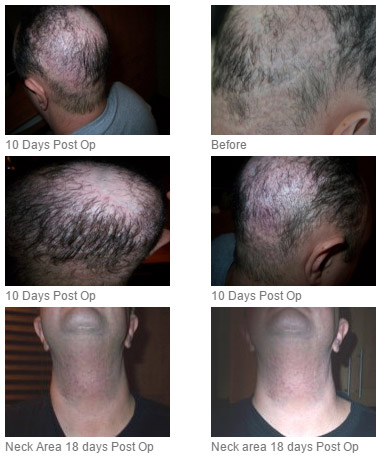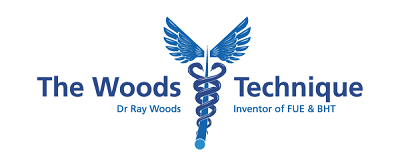Kingsley 2,500 FUE
Repair of Severe Scarring From Strip, Flap, Punch and Scalp Reduction Surgery Using 2500 FUE Grafts
Patient “Kingsley” had more than a dozen invasive procedures (scalp reductions, flaps, strip removals, punch procedures) over the years in an effort to combat his thinning hair. As a result his scalp was left a lumpy, scarred mess. The scars were very noticeable due to his lack of hair coverage, and the scars themselves created dead zones where hair would not grow in.
Job one for Dr. Woods was to create a normal, healthy look for the patient, covering up the unsightly scars. This was accomplished by transferring donor follicles from areas of the body other than the head – the abdomen, arms, chest, and neck. In the after image we can see that the patient’s scars are completely covered, leaving him looking much healthier.
Cruizer 4000 FUE BHT
4000 FUE Graft Hair Transplant By Dr Woods to Repair Scalp Flap and Strip Surgery
The patient highlighted in this video, “Cruizer,” had undergone numerous invasive surgical procedures (scalp flap and strip surgeries) to combat his thinning hair. As a result he has extensive scarring along the hairline and in the donor areas, as seen in the “before” images. In addition, the invasive procedures were not particularly successful – the coverage on the crown of the head is still quite thin and uneven, and the hairline along the front and temples is uneven, patchy, and unnatural looking. The “after” images show the results of Dr. Woods’ technique of transplanting hair from the patient’s abdomen and neck – the coverage of the crown is far better. The mess of the hairlines is cleaned up and natural looking. The scars from the previous procedures are covered up. In addition, there is no scarring left behind on the donor areas of the body and the neck.
Marky Repair of Scalp Flap
Scalp Flap Repair Using 1000 FUE Grafts Before and After Results By Dr Woods
In this video we see a patient who has very noticeable scars along his hairline that are a result of a scalp flap procedure. A scalp flap procedure involves cutting a strip of scalp that is still growing hair, leaving one end still attached to the scalp, and twisting it so it covers a thinning area. As seen in the “before” images, despite enduring such an invasive procedure the patient’s hair coverage was still thin and very uneven. Dr. Wood’s procedure of transplanting follicles on an individual basis leaves no such scarring. As seen in the “after” images, the coverage on the top of the patient’s head is even, allowing the patient to comb it any way he likes. In addition the scars along the hairline are now hidden from view.
“Marky” Scalp Flap Repair
1000 Graft FUE Hair Transplant Before and After Result Video By Dr Woods
This patient came to see Dr Ray Woods with severe scarring from previous multiple Scalp Flap procedures. His biggest concern was the scar that ran along his temporal and frontal hairline. The previous Scalp Flap surgeries had depleted his donor, so Dr Woods used Chest Hair for the bulk of the donor. The patient is very happy with his result and has booked in for a further procedure on his crown.
Daniel – Beard Hair Repair Case, 2007
Hair Transplant Using Beard Hair Before and After Result

Repair with beard hair. This patient had approximately 17 previous operations which included scalp reductions, flaps and strip excision.
He only has very sparse body hair which will be required to repair his frontal hairline. This meant there was no alternative other than beard hair to repair the massive scars on the back of his head which he otherwise had to disguise with a hair piece. 1,100 Beard Hair grafts were transplanted into the scar area under microscopic control utilizing the finest instrumentation and technique possible. Transection rates were approx. 5% Beard hair can be very coarse, feel sharp or prickly and look unnatural on the frontal scalp region but can be used to repair donor scars. The pinkness is fading gradually and now looks little more than a shaving rash. I wish to stress that Beard hair should be removed below the jaw line to avoid any possibility of pock marks and indentations on the face.
Beard Hair is not easy to remove and is prone to transection and damage in the removal process. If not done correctly, for every single good follicle, several follicles could be damaged and non viable. If Beard hair is to be considered the last body hair resource then careless removal must be avoided at all costs. This may deplete valuable stores below the jaw line and force some doctors to attempt removing beard hair from the face and this I believe is potentially problematic and only to be used as an absolute last resort.
Surgery Performed by Dr Ray Woods, Inventor FUE & BHT
About our Photos
All photos shown in our photo gallery are genuine. The stills are taken directly from video filming before, during and after the procedure using a Sony TRV 900E video camera. We have chosen this format because it provides the most accurate and true to life assessment possible despite the slightly diminished quality of the still photos transferred to our website. All patients can have access to their video record upon request. Still photographs taken from video allow us a complete and honest overview of before and after the procedure. However, these photos are not ‘Studio Glamour Portraits’ therefore soft focus, special lighting etc., has NOT been used. All videos have been taken by the doctors during consultation and the procedure.
These videos can be shown to you upon consultation confirming their authenticity.
